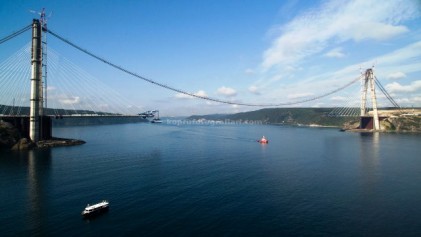3. Köprü dev taşıma operasyonları yarattı
20/02/2016 - 12:48:00
Üzerinden 8 şeritli karayolu ve 2 şeritli tren yolu geçecek olan 3. Boğaz Köprüsü, dev taşıma operasyonları yarattı.
 Yatırım bedeli 4.5 milyar TL olan köprünün inşaatı için dünyanın dört bir yanından malzeme taşıması yapıldı. Bazı çelik ürünler Güney Kore’den ve Malezya’dan, döküm kule ve dağıtım semerleri İtalya’dan getirildi. Fransa, Almanya, Çin gibi ülkelerden de malzeme getirilirken, sevkiyatlar için genellikle denizyolu tercih edildi. Denizyolu ile gelen malzemeler, çoğunlukla Ambarlı Limanı’ndaki gümrük alanına ulaştırıldı. Malzemeler gümrük işlemlerinin akabinde çok dingilli kara taşıtları ile şantiye alanına sevk edildi. 3. Boğaz Köprüsü için sevkiyatı zor yapılan malzemeler ise en ağırı 923 ton olan çelik tabliyeler oldu. Bugüne kadar 59 çelik tabliyeden 48'inin montaj ve kaynak işlemi tamamlandı. Asya ve Avrupa yakasının birleşmesine 247 metre kaldı. 3. Boğaz Köprüsü'nün taşıma sistemlerinden sonuncusu olan askı kablolarının dev parçaları büyük bir lojistik operasyonuyla Çin'den Türkiye'ye getirildi. 106 tonluk ilk bölüm, özel olarak tasarlanan sistem sayesinde havayolu Rus yapımı dev Antonov uçağıyla iki gün içinde Çin'den İstanbul'daki inşaat sahasına ulaştırıldı. Kalan kabloların sevkiyatının ise 2 parti halinde denizyoluyla yapılması planlanıyor. Kuzey Marmara (3. Boğaz Köprüsü Dahil) Otoyolu Projesi’nin tamamlanması ve diğer ulaşım modları ile gerekli entegrasyonun sağlanmasıyla İstanbul şehir içi trafiğinde yaşanan yoğunluğun azaltılması hedefleniyor.
Yatırım bedeli 4.5 milyar TL olan köprünün inşaatı için dünyanın dört bir yanından malzeme taşıması yapıldı. Bazı çelik ürünler Güney Kore’den ve Malezya’dan, döküm kule ve dağıtım semerleri İtalya’dan getirildi. Fransa, Almanya, Çin gibi ülkelerden de malzeme getirilirken, sevkiyatlar için genellikle denizyolu tercih edildi. Denizyolu ile gelen malzemeler, çoğunlukla Ambarlı Limanı’ndaki gümrük alanına ulaştırıldı. Malzemeler gümrük işlemlerinin akabinde çok dingilli kara taşıtları ile şantiye alanına sevk edildi. 3. Boğaz Köprüsü için sevkiyatı zor yapılan malzemeler ise en ağırı 923 ton olan çelik tabliyeler oldu. Bugüne kadar 59 çelik tabliyeden 48'inin montaj ve kaynak işlemi tamamlandı. Asya ve Avrupa yakasının birleşmesine 247 metre kaldı. 3. Boğaz Köprüsü'nün taşıma sistemlerinden sonuncusu olan askı kablolarının dev parçaları büyük bir lojistik operasyonuyla Çin'den Türkiye'ye getirildi. 106 tonluk ilk bölüm, özel olarak tasarlanan sistem sayesinde havayolu Rus yapımı dev Antonov uçağıyla iki gün içinde Çin'den İstanbul'daki inşaat sahasına ulaştırıldı. Kalan kabloların sevkiyatının ise 2 parti halinde denizyoluyla yapılması planlanıyor. Kuzey Marmara (3. Boğaz Köprüsü Dahil) Otoyolu Projesi’nin tamamlanması ve diğer ulaşım modları ile gerekli entegrasyonun sağlanmasıyla İstanbul şehir içi trafiğinde yaşanan yoğunluğun azaltılması hedefleniyor.
The 3rd Bridge creates colossal transport operations
The 3rd Bosphorus Bridge, on which a 8-lane motorway and 2-lane railway will pass, has created colossal transport operations as well. For the construction of the Bridge, whose investment value is 4.5 billion TL, materials from all over the world were carried. The materials with most difficulty in shipment were the steel deck slabs, the heaviest of which was 923 tons. Giant parts of the suspension cables were carried from China to Turkey by air transport through a substantial logistics operation.
The 3rd Bosphorus Bridge included in the scope of the Northern Marmara Highway Project carried out by the IC İçtaş – Astaldi JV will be the widest suspension bridge of the world with a width of 59 meters and longest spanning one that has a rail system on it, with a main span of 1,408 meters. Another breakthrough of the bridge is that it is the suspension bridge with the highest tower of the world with a height of more than 322 meters. A 8-lane motorway and 2-lane railway will pass at the same level over the 3rd Bosporus Bridge that will be of a product with cutting edge technology and engineering. The rail system to be situated at the Odayeri – Paşaköy section of the North Marmara Highway Project will carry passengers from Edirne to Izmit. Ataturk Airport, Sabiha Gökçen Airport, and newly built 3rd Airport will be connected with each other with the rail system that will be integrated with Marmaray and Istanbul Subway.
SHIPMENTS WERE CONDUCTED FROM MANY PLACES
Construction of the 3rd Bosporus Bridge started in 2013 is ongoing at full throttle. The bridge project targeted to be completed this year has created considerable amount of logistics operation as well. Shipments of materials from many countries of the world were conducted for the project. Some steel products were brought from South Korea and Malaysia and casting tower and distribution saddles from Italy. Materials were also brought from other countries like France, Germany, and China and sea transportation was preferred for their shipments. The materials arriving by sea were mainly delivered to the customs area at the Port of Ambarlı. They were transferred to the worksite area after the customs clearances via multi-axle land vehicles.
GIANT SLABS WERE CARRIED VIA SEA
The materials with difficult shipment were the steel deck slabs, the heaviest of which was 923 tons. The steel plates coming from South Korea were rendered ready for panel production in the plant in Gebze, Izmit, and then, panel production was carried out in the factory in Istanbul’s district of Tuzla. Subsequent to the production of the panels, they were dispatched to Altınova, Yalova, to make the steel deck slabs. The deck slabs were dispatched from there to the construction area on a ship. The traffic of the Bosporus was temporarily closed during the dispatch of the deck slabs and their removal from the ship. During the dispatch of the deck slabs and their removal from the ship, varied factors were handled and evaluated in terms of weather conditions and marine transport technique and planning was conducted accordingly. Mounting and welding of 48 of the 59 steel deck slabs have been conducted so far. There has been 247 meters left for the merger of the Asian and European sides.
Within the scope of the project, a giant crane with 1250 ton carriage capacity was brought to the project site in the form of parts for lifting and placement of the first steel deck slab with 4,5 meters of length and approximately 400 tons of weight. The parts of the paletted crane were carried with 45 trailer trucks. Total period of mounting lasted 4-5 days. During the assembly of the crane, 2 mobile cranes, with 500 tons and 130 tons capacity, were used.
LOGISTICS OPERATION FROM CHINA TO ISTANBUL
Giant parts of the suspension cables that were the last carriage systems of the 3rd Bosporus Bridge were carried from China to Turkey by air transport through a substantial logistics operation. 106-ton section was brought to the construction site in Istanbul from China with Russian giant Antonov aircraft thanks to the custom design system. During the logistics operation, the packaging system that was specifically designed and that reminds a giant cage as a result of the harmonious operation of aircraft engineering and logistics expertise ensured that the weight of the cargo was distributed within the aircraft equally. This way, the shipment was completed successfully with the flight safety maintained as the basic priority. The suspension cables designed in South Korea and manufactured in China will carry the last deck slabs that will combine both sides in the construction of the bridge. It is planned that the shipment of the remaining cables will be conducted by sea transport in 2 lots.
The target is to reduce the intensity experienced in the Istanbul provincial traffic with the completion of the North Marmara Highway Project (including 3rd Bosporus Bridge) and provision of the necessary integration with the other transport modes. When the air pollution and environmental problems resulting from the heavy traffic are eliminated, total 1,785 billion-dollar economic loss, approximately 1.450 billion-dollar of which is energy loss and 335 million- dollar workforce loss, will be prevented.
MARMARAY’S LOGISTICS BACKSTAGE
The first stage of Marmaray which is named as "Project of the Century" with a history of 150 years and beyond, was put into service on 29th October 2013. This part of 13.5 km length consists of 5 stations, which three of them are underground. Marmaray, which goes underground in Yedikule after Kazlıçeşme, moves thorough Yenikapı and Sirkeci, crosses through under Bosphorus, and reaches underground station at Üsküdar Istanbul in Anatolian Side (Asia), then it goes on ground in Ayrılıkçeşme station and then ends in Söğütlüçeşme. When Halkalı-Kazlıçeşme line part which enhancement works is ongoing for, completed it will be connected to Marmaray. It is planned to transport 75,000 passengers an hour in one direction, when the project is fully commissioned.
Total line length will be 76 km. “Bosporus Railway Tube Crossing and Gebze-Halkalı ground metro will not only carry passengers but cargo transportation will be performed as well. When the Project is commissioned, 42 merchandise trains will be operated on line between Gebze-Halkalı. 42 train services in total provided that 21 is outgoing and 21 is incoming, will be operated in a day when the Project is completed. This project will not only connect Anatolian and European sides, it will connect London and Beijing with an uninterrupted railway line in one sense.
Portion of Logistics cost in total costs is 0.3% in Bosporus Railway Tube Crossing (Marmaray) Project. Tubes that were placed under Bosporus within scope of the Project were manufactured in Tuzla Dockyard. Turkish engineers were work on construction of tubes whose engineering works have been performed by Japan engineers. One tube lengths 135 meter and widths 15 meter and weights approximately 18 thousand tons. 11 Tubes in total whose lengths vary between 98,5 meter and 135 meter have been used in Marmaray Project. Tubes have been produced in Tuzla and then submerged Büyükada offshore. The most difficult to transport equipment was Tunnel Boring Machine in the Project, which companies as Öznakliyat, Batı Nakliyat, Mağdenli and Kamigumi have provided services for.























































